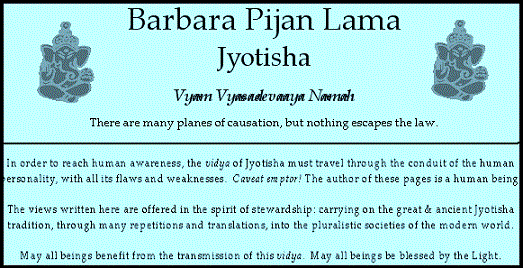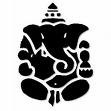

विम्शोत्तरि दशा
Compared to
Vimshottari period of Ketu
Rahu-Ketu: Directory of
Jyotisha Descriptions
Ketu Mahadasha and the bhukti of Ketu can
give quite similar results to the periods of Shani.
Isolation,
self-concern,
fear,
separation,
survival
pressure etc. are attributes of both Shani and Ketu.
Shani bhukti produce a pulsing physical survival
signal from the reptile brain. Shani bhukti focus attention on
acquiring and defending one's hoard,
while casting an anxious eye toward the
future. Whether one's need is material (food,
clothing,
shelter,
cintamani * mani * money
) or political (power,
recognition,
control) or psychic (creativity,
space,
free time,
privacy) the native feels a powerful obligation to feed that
need .
By contrast, Ketu is detached,
disconnected,
and
apathetic. Ketu feels no survival drive. Ketu tends to accept fate,
wandering
aimlessly, hopeless and often deranged.
Shani bhukti are practical,
materialistic,
and self-concerned .
Although Shani bhukti can be very difficult physically and emotionally,
shani
bhukti are rarely permanently crippling. Shani strengthens the moral judgment
and create a more solid foundation for better times in the futurer.
Ketu has no sense of separate self, so being cut off from
other selves is rather a non-starter for Ketu. Ketu doesn't care about food,
clothing,
and shelter.
Ketu is out of touch with The earthen body .
Ketu does not hear the reptile brain signal except very
faintly,
and usually only then if Ketu is associated with Shani.
Shani bhukti keep the native focused on defending his
fortress. Ketu periods typically involve wandering . Bhukti of
Ketuva may create a pattern of physical, emotional,
or mental wandering - the
energetic level at which the wandering occurs will be defined by Ketu's house,
His lord,
and any drishti coming to Ketu from other graha. But in general the
physical wandering component as in"pilgrimage" is fairly strong, especially if
Ketu is angularr.
By contrast to Shani,
Ketu is not a hoarder
and Ketu knows nothing about boundaries. Ketu is open and"trusting" -- but not
trusting in the sense of expecting a specific,
predictable result from a defined
relationship. With Shani,
relationships may be highly negative as in predatory
and recognition-denying,
but Shani is clear and firm on this cause-and-effect
relationship. Shani is a clear if negative thinker.
Ketu is "trusting" in the sense of having no
expectations either positive or negative. Any outcome is acceptable to Ketu.
Unlike Shani who is specifically building toward a secure future, Ketu has no
stake in the future. Ketu does not recognize Time and has no interest nor
capacity to invest in the future. Nor does Ketu care about the past,
naor learn
from the past nor have any attachment to history or tradition (which Shani
highly values).
Ketu's highly permeable"always open" willingness to
share the food,
body,
and other resources with any who enquire may create
either a tamasic or a sattvic effect. As always the final results of
Ketu depend absolutely upon the graha who controls Ketu's rashi,
along with
graha who send drishti,
svabhava lord, etc.
Ketu exemplifies what modern psychology calls
"attachment deficit disorder" . Ketu natives may appear to form relationships
but they act like pre-verbal infants,
attaching themselves to virtually any
caretaker. Results of these no-expectation relationships range from
serendipitous to unsavory. If Ketu is yuti Moon,
this wandering and
psycho-emotional permeability is a lifelong condition,
much exacerbated during
Ketu bhuktir.
As a manifestation of Shri Ganesha,
Ketu can
provide superior spiritual results. Complete detachment from material
welfare including core ambivalence toward fleshly survival can produce a great
Saint.
At lower levels of consciousness, Ketu is associated
with a lack of Appropriate personal boundaries
which generates a victim state
: moral breakdown utter loss of social dignity profligacy and disrepute.
However,
at the higher levels of consciousness the Ketu native consciously
chooses to abandon the energy-consuming practice of managing social boundaries,
and concentrate instead on Absorbing the omnipresence of the Divine.
In sum,
certain effects of Shani and Ketu will appear
similar. Isolation,
social disconnection,
frustration and alienation in human
relationships,
scarce resources,
and a feeling of circumstances beyond one's
control,
are common factors. Also,
both Shani bhukti and Ketu period can produce
excellent spiritual results.
The key difference = Shani is urgently concerned with
survival whereas Ketu is apathetic. As a result,
shani bhukti are characterized
by hard work,
planning,
and stern self-reliance whereas Ketu periods feature
ambivalence,
wandering and unexpected social relationships

 file update =
21-Apr-2024
file update =
21-Apr-2024
[Copyright 1994-2094 by Barbara Pijan Lama] [Contact] [How to Request a Jyotishavidya Reading]
Barbara Pijan Lama Jyotishavidya Vedic Astrology Surya Sun Chandra Moon Mangala Mars Budha Mercury Guru Jupiter Shukra Venus Shani Saturn Rahu Ketu Graha Planets Dasha Timeline Calendar Nakshatra Navamsha Marriage Children Treasury Career Spiritual Wisdom Cycles of re-Death and re-Birth
The information on barbarapijan.com , including all readings and reports, is provided for educational purposes only. Wishing you every happiness and continuing success in studies!